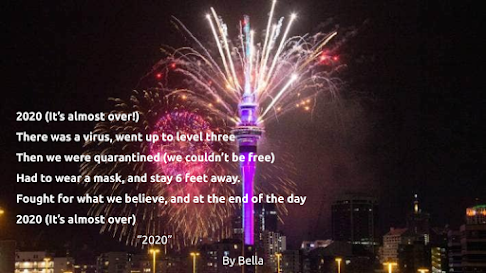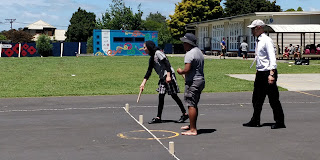Today, I completed the step it up level for the Summer Learning Journey activity called Tānerore. I created a unique kowhaiwhai pattern using the koru and kape.
I am a Year 7 student at Panmure Bridge School in Auckland, NZ. I am in Learning Space 2 and my teachers are Mrs Anderson and Mrs Fisi'iahi.
Friday, 18 December 2020
Summer Learning Journey | Day 4 | Step it Up | Tānerore
Summer Learning Journey | Day 4 | Step it Up | Insect/Summer Art
Summer Learning Journey | Day 4 | Activity 3 | Summer Haiku
Summer Learning Journey | Day 4 | Activity 2 | Which One Doesn't Belong?
Summer Learning Journey | Day 4 | Activity 1 | Rise Up
Thursday, 17 December 2020
Summer Learning Journey | Day 3 | Activity 3 | Optical Illusions: Step It Up!
Commenting Thread
Wednesday, 16 December 2020
Summer Learning Journey | Day 3 | Activity 3 | Optical Illusions
Summer Learning Journey | Day 3 | Activity 2 | Tānerore
Summer Learning Journey | Day 3 | Activity 1 | What are you doing today? | Kick Start
Tuesday, 15 December 2020
Summer Learning Journey | Day 2 | Activity 2 | Insect Art
Summer Learning Journey | Day 2 | Activity 1 | Kick Start Literacy | Fishing False Teeth
Summer Learning Journey | Day 1 | Activity 2 | Your Comment Counts
Monday, 14 December 2020
Summer Learning Journey | Day 1 | Activity 1 | Nanogirl | Scavanger Hunt:
Commenting Thread
I commented on Dayton's blogpost on making connections. He informed about the different connects the readers can make and he told how to make those connections.
LI: to make a dialogic conversation.
Inquiry | Persuasive Presentation
Friday, 11 December 2020
Commenting Thread
Writing | Film Finalising
Badge Bidding
Summer Learning Journey | Teaser Week 1 | Elements of Art
Texture is how a surface feels. There are a variety of different textures. The texture of this art is hard and rough because it is a woodblock print which is art carved from a block of wood.
Thursday, 10 December 2020
Reading | Cloze Comprehension
Basic Facts Boxes | Addition and Subtraction | Speed Demon Challenge
Basic Facts Boxes is a can-do activity that helps improve a persons maths skills and challenges the person to quickly solve basic maths facts of all operations.
Maths | Basic Facts Boxes | Speed Demon
Basic Facts Boxes is a can-do activity that helps improve a persons maths skills and challenges the person to quickly solve basic maths facts of all operations.
Reading | SSR Selfie | The Wide Window
SSR Selfie is a can-do activity that encourages readers to retell a story that they have read, and using detail in their summaries so that the audience can understand and find interest in that certain book.
Inquiry | Presentation
Summer Learning Journey | Teaser Week 1 | Kick Start Art
Wednesday, 9 December 2020
Maths | Quiz Results
Maori | Nga Taone o Te Ika a Maui
Tuesday, 8 December 2020
Reading | Cloze Comprehension
Writing | Commanding Conversations
Friday, 4 December 2020
Commenting Thread
A comment thread is a conversation between two people that consists of a greeting, positive feedback and an open question. The different between an open question and a closed question is that an open question requires more thinking to give an answer and it expands the conversation. A closed question only needs a few words for an answer, and it does not expand the conversation.
Maths | Testing Knowledge
Maths | Basic Facts Boxes | Addition and Subtraction
Basic Facts Boxes is a can-do activity that helps improve a persons maths skills and challenges the person to quickly solve basic maths facts of all operations.
Reading | SSR Selfie | A Series of Unfortunate Events
This week, I have done my SSR Selfie activity on a book called 'A Series of Unfortunate Events' by Daniel Handler illustrated by by Brett Helquist. This is a fiction book about three orphaned children trying to find a new home, and discovering the mystery behind their parent's death. This task was not made easy because Count Olaf was trying to steal the children's fortune.
Inquiry | Model Making
Our focus for inquiry was to create a net of our protection shelter, transfer that net onto cardboard and use those cardboard pieces to create a model of our structure.
First, our company sketched a 3D net with paper. While doing this, we thought of how to use the paper as efficiently as possible in order to save resources. We then measured the 3D net dimensions onto a bigger piece of paper. Our company decided to draw the parts of the net separately to make the process easier.
Next, we transferred the 3D net onto cardboard and cut out the separate pieces. We needed to use as least cardboard as we could so the other companies could use it. After that, we began using the cardboard pieces to create our shelter model.
We placed the cardboard walls onto the base of the shape and held it together using the popsicle sticks and hot glues to help keep a good foundation in order to keep the structure standing. We also used tape to hold the shape of the walls in place.
Our shelter was a hexagonal pyramid and we found it hard to make because it is a complex shape. Our company found it enjoyable to make and plan out the shelter.
LI: to build shelter models.
Kiwi Sport | Touch Rugby | Passing Drills | Attacking and Defending
Our focus for Kiwi Sport, touch rugby was to practice using three and two man settles.
LI: to practice using three and two man settles.
Maori | Maori Place Names
Our session's focus with Whaea Odie was looking for words inside phrases to translate them into english properly. Another focus was to expand our Maori vocabulary.
Tuesday, 1 December 2020
Writing | Beginning Filming
Reading | Fact Find
Reading | Sequence of Events | Evaluating Text Understandings
A novel study analyses information from a story to develop a persons literature skill and understanding of the text. This novel study is based around the story, 'Matilda'. Matilda is about a little girl who loves to read, and is incredibly smart. However her own family treats her unequally.
Friday, 27 November 2020
Kubb | Warrior Game
Kiwi Sport | Touch Rugby
LI: to practice using three and two man settles.









































